
Ginataan, alternatively spelled guinataan, is a Filipino term which refers to food cooked with gatâ. Literally translated, ginataan means "done with coconut milk". Due to the general nature of the term, it can refer to a number of different dishes, each called ginataan, but distinct from one another.

Lugaw, also spelled lugao, is a Filipino glutinous rice dish or porridge. Lugaw may refer to various dishes, both savory and sweet. In Visayan regions, savory lugaw are collectively referred to as pospas. Lugaw is widely regarded as a comfort food in the Philippines.

Kalamay is a sticky sweet delicacy that is popular in many regions of the Philippines. It is made of coconut milk, brown sugar, and ground glutinous rice. It can also be flavored with margarine, peanut butter, or vanilla. Kalamay can be eaten alone; but is usually used as a sweetener for a number of Filipino desserts and beverages. It is related to the Chamorro dessert called Kalamai.

Puto is a Filipino steamed rice cake, traditionally made from slightly fermented rice dough (galapong). It is eaten as is or as an accompaniment to a number of savoury dishes. Puto is also an umbrella term for various kinds of indigenous steamed cakes, including those made without rice. It is a sub-type of kakanin.

Laing, is a Filipino dish of shredded or whole taro leaves with meat or seafood cooked in thick coconut milk spiced with labuyo chili, lemongrass, garlic, shallots, ginger, and shrimp paste. It originates from the Bicol Region, where it is known simply as pinangat. Laing is also a type of ginataan, and thus may also be referred to as ginataang laing. Laing is commonly eaten as a vegetable side to complement meat or fish side dishes known as ulam in Filipino, which is normally paired with boiled white rice.

Binignit is a Visayan dessert soup from the central Philippines. The dish is traditionally made with glutinous rice cooked in coconut milk with various slices of sabá bananas, taro, ube, and sweet potato, among other ingredients. It is comparable to various dessert guinataán dishes found in other regions such as bilo-bilo. Among the Visayan people, the dish is traditionally served during Good Friday of Holy Week.

Arroz caldo is a Spanish term meaning "broth rice". It is derived from the Spanish dish arroz caldoso.

Sinabawang gulay, usually anglicized as Filipino vegetable soup, is a Filipino vegetable soup made with leafy vegetables and various other vegetables in a broth seasoned with seafood stock or patis. The ingredients of the dish can vary widely. It is eaten on its own or over white rice.

Congee is a form of savoury rice porridge made by boiling rice in a large amount of water until the rice softens. Depending on rice-water ratio, the thickness of congee varies from a Western oatmeal porridge to a gruel. Since the history of rice cultivation in Asia stretches back to the Baiyue-inhabited lower Yangtze circa 10000 BC, congee is unlikely to have appeared before that date. Congee is typically served with side dishes, or it can be topped with meat, fish and pickled vegetables.

Gising-gising, also known as ginataang sigarilyas, is a spicy Filipino vegetable soup or stew originating from the province of Nueva Ecija, and was later introduced by Novo Ecijanos to Pampanga province. It is traditionally made with chopped winged beans, and coconut milk spiced with labuyo chili, garlic, onions, and bagoong alamang. The name literally means "wake up, wake up". It can be eaten alone, on top of rice, or as a side dish to grilled meat dishes. It is a type of ginataan.
Binatog, also known as binatong itlog, bualaw or kinulti, is a Filipino boiled corn dessert topped with freshly grated coconut, butter, and salt or sugar. It is commonly sold as street food in the northern Philippines by vendors known as magbibinatog carrying characteristic large tin cans, similar to taho vendors.

Ginataang kalabasa, also known as kalabasa sa gata, is a Filipino vegetable stew made from calabaza in coconut milk and spices. It commonly includes shrimp and yardlong beans and either bagoong or patis. It can also be cooked with fish, crab, or meat and a variety of other ingredients. It is a creamy umami-laden dish that is naturally slightly sweet due to the calabaza. It is a type of ginataan.

Samalamig, also known as palamig, is a collective term for various Filipino sweet chilled beverages that usually include jelly-like ingredients. They come in various flavors, and are commonly sold by street vendors as refreshments. Typical ingredients of the drinks include gulaman (agar), sago pearls, kaong, tapioca pearls, nata de coco, and coconut. They are usually anglicized as pearl coolers or pearl and jelly coolers.

Minatamis na saging is a Filipino dessert made with chopped saba bananas cooked in a sweet syrup (arnibal) made with muscovado sugar and water. Some recipes also add a little bit of salt and pandan leaf or vanilla extract. Other ingredients can also be added like sweet potato, sago, or other fruits like jackfruit. It can be eaten on its own or added as an ingredient to other desserts. Adding the dessert over milk and shaved ice also results in another dessert known as saba con yelo.

Ginataang langka, is a Filipino vegetable stew made from unripe jackfruit in coconut milk and spices. The dish includes a wide variety of secondary ingredients like seafood, meat, and other vegetables. The dish also commonly adds bagoong alamang and may be spiced with chilis or soured with vinegar. Notable variants of the dish are ginataang kamansi and ginataang rimas which use breadnut and breadfruit, respectively. Ginataang langka is a type of ginataan.

Ginataang hipon is a Filipino seafood soup made from shrimp (hipon) in coconut milk (gata) and spices. It differs from other types of ginataan, in that it does not use vegetables. It is a type of ginataan. Variants of the dish include ginataang curacha and ginataang sugpo, which use spanner crabs and prawn, respectively, in place of shrimp.

Ginataang munggo, also known as lelut balatung in pampanga or tinutungang munggo, is a Filipino glutinous rice gruel dessert with toasted mung beans, coconut milk, and sugar. It is typically flavored with vanilla or pandan leaves. Corn and fruits like jackfruit or banana may also be added. It is a type of lugaw and ginataan.

Ginataang isda is a Filipino fish stew made from fish and leafy vegetables in coconut milk with garlic, ginger, onion, patis or bagoong alamang, and salt and pepper. It is a type of ginataan. A common version of the dish, known as ginataang paksiw na isda or paksiw na isda sa gata, is additionally soured with vinegar. Ginataang isda is a type of ginataan.

Ginataang kuhol is a Filipino snail stew made from apple snails in coconut milk with leafy vegetables, onion, garlic, ginger, siling haba chilis, bagoong alamang, and salt and pepper. Labuyo chilis are also commonly added for a spicier version. The leafy vegetables can include water spinach, moringa leaves, and chili pepper leaves, among others.

Sinanglay is a Filipino dish made from stuffed fish wrapped in leafy vegetables and lemongrass or pandan leaves cooked in a spicy coconut milk sauce. It is a type of ginataan and originates from the Bicol Region.




















